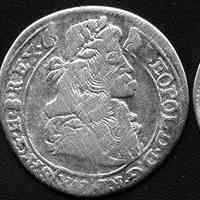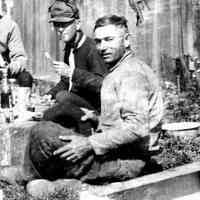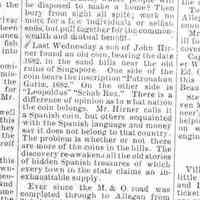Singapore coin story

2023.10.393
Treasure in the Singapore Sands? --submitted by Chris Yoder, Nov. 2009 The Lake Shore Commercial (Commercial Record) of March 4, 1887 reported: "Last Wednesday a son of John Hirner found an old coin bearing the date 1682, in the sand hills near the old ruins of Singapore. One side of the coin bears the inscription "Patronahun Gaviae 1682." On the other side is "Leopoldus" "Schab Rex." There is a difference of opinion as to what nation the coin belongs. Mr. Hirner calls it a Spanish coin, but others acquainted with the Spanish langauge and money say it does not belong to that country. The problem is whether or not there are more of the coins in the hills. The discovery re-awakens all the old stories of hidden Spanish treasures of which every town in the state claims an inexhaustiable supply." Michigan was under the government of the French from 1634 until 1760. The year of this old coin was the year that Rene-Robert Cavelier, Sieur de La Salle (1643-1687) discovered the headwaters of the Mississippi River. In his sketch of St. Joseph, Michigan, Robert C. Myers writes that the French Crown wanted to strengthen French ties with the Miami Indians and granted the Jesuits a tract of land along the St. Joseph River to establish a mission about 1684. In the fall of 1691 Ensign Augustin Legardeur de Courtemanche, apparently with a small force of soldiers, built a military post near the mission. This outpost, became known as Fort St. Joseph, and was located near present day Niles, Michigan. "Fort St. Joseph became the keystone of French control of the southern Lake Michigan region-served as a military, commercial and diplomatic center to influence and develop trade with the French-allied Indians." Today Niles maintains a small museum to the Fort which is open several days each week to visitors. Certainly a coin minted in 1682 could have found its way into the "New World" with the Jesuits by 1684, or the decades thereafter. But was the coin found by that Saugatuck youngster a French coin? The wonders of the internet tell us it was a silver Hungarian coin, minted under the rein of King Leopold from 1661 to 1686, with Leopold's bust surrounded by a laurel wreath on one side and the Madonna and Christ child on the other. "Patronahun Gaviae" was really "PATRONA HVNGARIAE (Hungary)". Was it part of a yet unfound treasure hoard lying in the sands of Singapore, or just a single coin dropped by an early French explorer, Jesuit priest, or Indian ally? Perhaps as construction crews put in the future condos and horse trails they will unearth a "pot of gold"? (silver?) Herman Hirner enjoys picnic lunch, Osa Welch in Background And what became of the young boy who found the coin? Six year old Herman Hirner was to live out his life in Saugatuck. He served in WWI and worked for the Saugatuck Lumber and Coal Company. In 1940 he married Idessa Annable, daughter of summer resorters from Chicago who had come to Saugatuck beginning in 1893. At the time of his death in 1966, he was serving as Saugatuck Village Assessor. Herman passed away at his residence, 642 Lake St., and was interred in Riverside cemetery.
1836 Singapore1800 Fur Trading
Winthers, Sally
Digital data in CatalogIt
Hirner, Herman 1881-1966
This information was copied from the pre-2023 SDHC website. The location of an original version was unknown at the time of cataloging.
01/11/2024
01/13/2024



